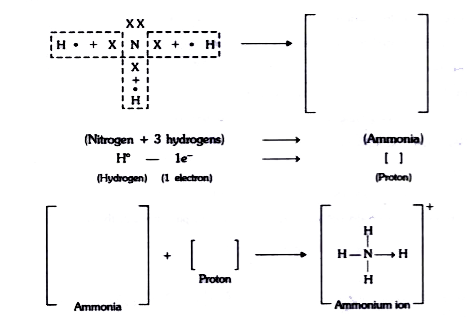Complete Solutions to WORKSHEET-3 of chapter CHEMICAL BONDING of Class 10 book with complete answers and questions
| Class 10 | CHEMISTRY |
| Chapter | CHEMICAL BONDING |
| EVERGREEN PUBLICATION | WORKSHEET-3 |
| Number Of Questions | 8 |
| Academic Year | 2023-24 |
Complete the following electron dot diagrams :
`underset("Ammonia")(H:underset(H)underset(* *)overset(H)overset(* *)N: )+underset("Proton")(H^(+)) to `
View SolutionComplete the following electron dot diagrams :
`underset("Water")(H:underset(* *)overset(* *)O:H)+underset("Proton")(H^(+))to`
View SolutionComplete the following electron dot diagrams :
`underset("Water")(H:underset(* *)overset(* *)O:H)+underset("Proton")(H^(+))to`
View SolutionExplain :
Cation has smaller size than neutral atom.
………………………………………………………………………………………….
View SolutionExplain :
Anion has larger size than neutral atom.
………………………………………………………………………………………….
View SolutionExplain:
Electrolysis can distinguish between covalent and ionic compounds.
………………………………………………………………………………………….
View SolutionExplain:
Cation has a smaller size than parent atom.
………………………………………………………………………………………….
View SolutionComplete the following flow chart related to the structure of ammonium ion.
N(7) `to` _____, _____ (electronic configuration) H(1) `to` _____ (electronic configuration) Nitrogen needs __________ electrons to complete its octet and hydrogen needs _________ electron to complete its duplet.

Ammonia possesses one __________ pair of electrons and three __________ pairs of electrons. Thus the pair of electron is used in making a _________ with proton. Such a bond is known as ________ bond.
View Solution
WORKSHEET-3 questions and complete solutions for chapter CHEMICAL BONDING of EVERGREEN CHEMISTRY (ENGLISH) of Class 10
All Exercises from EVERGREEN PUBLICATION Class 10 CHEMISTRY CHEMICAL BONDING
- ADDITIONAL QUESTION
- Additional Questions for Practice
- ILLUSTRATIVE ASSIGNMENTS
- Question
- QUESTION FOR PRACTICE
- QUESTION FOR PRACTICE (Fill in the blanks by selecting a correct word given in the brackets.)
- QUESTION FOR PRACTICE ON EXAMINATION PATTERN
- QUESTIONS
- QUESTIONS (Fill in the blanks from the choices given in the brackets)
- Questions from Previous ICSE Board Papers (2005)
- Questions from Previous ICSE Board Papers (2006)
- Questions from Previous ICSE Board Papers (2007)
- Questions from Previous ICSE Board Papers (2008)
- Questions from Previous ICSE Board Papers (2009)
- Questions from Previous ICSE Board Papers (2010)
- Questions from Previous ICSE Board Papers (2011)
- Questions from Previous ICSE Board Papers (2012)
- Questions from Previous ICSE Board Papers (2013)
- Questions from Previous ICSE Board Papers (2014)
- Questions from Previous ICSE Board Papers (2015)
- Questions from Previous ICSE Board Papers (2016)
- Questions from Previous ICSE Board Papers (2017)
- Questions from Previous ICSE Board Papers (2018)
- UNIT TEST PAPER 2
- WORKSHEET-1
- WORKSHEET-1 (Answer the following questions)
- WORKSHEET-1 (Fill in the blanks with suitable words)
- WORKSHEET-2
- WORKSHEET-2 (Fill in the blanks with appropriate words)
- WORKSHEET-3
- WORKSHEET-3(Give one word for the following)
- WORKSHEET-3(Tick the correct answer)